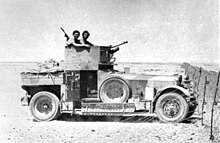Armoured car regiment
Armoured Car Regiments were
Regimental organisation in the Second World War
Armoured car regiments were a component of the Royal Armoured Corps. Similarly equipped units of the Reconnaissance Corps were organic parts of infantry divisions during the Second World War.
France 1940
In the 1940 campaign in France and Flanders, the 12th Royal Lancers was the sole armoured car regiment fielded by the British Expeditionary Force.[1] During the 1940 campaign, the 12th Lancers had an authorized strength of 38 armoured cars and about 380 men organised into a headquarters and three squadrons. This regiment served as the army-level reconnaissance asset of the B. E. F.
The war in the desert

In the open spaces of North Africa, armoured reconnaissance was extensively used by both the Axis and the British and Commonwealth) forces. Changes in doctrine made the armoured car regiment an organic asset of the armoured divisions, in which role the regiments typically fielded between 50 and 60 armoured cars ranging in type from older Rolls-Royce armoured cars to more modern Humber types. Less heavily armed scout cars such as the Humber Scout Car were used as well. During the
Italy and northwestern Europe 1943-45
Commonwealth and other forces
Besides the British Army, Canada, Poland, Southern Rhodesia, and the Union of South Africa also fielded armoured car regiments organised along British lines and employed against Axis troops in North Africa, Italy, and northwestern Europe. Australian forces fielded the 2/11 Armoured Car Regiment, but it was not employed in combat.
Second World War organization and vehicles
- Daimler and/or Humber armoured cars - Sabre squadrons
- Humber Light Reconnaissance Car
- Staghound armoured car - used as regimental and squadron headquarters vehicle[4]
- Two M3 Gun Motor Carriage (75mm gun on half-tracks) per squadron, eight in total in a regiment, though generally used as a regimental battery[4]
- Staghound or Humber AA vehicle - four per regimental HQ[4]
Postwar
For decades after the Second World War, the British Army of the Rhine and forces in the U.K. maintained armoured car regiments whose mission remained tactical armoured reconnaissance on conventional battlefields. The 4th Queen's Own Hussars saw combat in the Malayan Emergency from 1948-51 as an armoured car regiment. Other armoured car regiments such as the Royal Horse Guards were deployed to United Nations Peacekeeping Force in Cyprus as a result of the unrest and military events there.
The last armoured car intended for conventional battlefield use, the Fox armoured reconnaissance vehicle, was withdrawn from active British service in 1994 and replaced by tracked reconnaissance vehicles like the Sabre. Although reconnaissance regiments like the Household Cavalry Regiment remain active in the British Army, they no longer operate armoured cars and hence the British forces no longer field armoured car regiments.
Notes
- ^ Major L. F. Ellis, The War In France and Flanders 1939-1940 (History of the Second World War), "APPENDIX I British Forces Engaged" via Hyperwar
- ^ Rothwell.force9.co.uk, East Africa Command
- ^ "Bayonetstrength site". Archived from the original on 2008-12-29. Retrieved 2008-10-21.
- ^ a b c Crow p.102-104
Sources
- Duncan Crow, AFV Weapons Profile Book No.2 British and Commonwealth Armoured Formations (1919-1946), Profile Publishing
- East Africa Command
- Ellis, Major L. F. (1954), "Appendix I: British Forces Engaged", in Butler, J. R. M. (ed.), The War In France and Flanders 1939-1940, History of the Second World War, London: HMSO – via Hyperwar Foundation
- Bayonetstrength description of late war regiment
